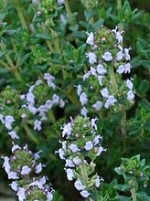 Also called English thyme, this well branched aromatic evergreen shrub is native to the western Mediterranean region to southern Italy. It is a member of the mint family, Lamiaceae, that also includes basil, rosemary, and beebalm. Plants grow 6-12” tall and have a woody base and ¼” –1/2” long lanceolate gray-green leaves with margins rolled under. The ¼” tubular lilac to pink flowers are carried in whorls in small terminal clusters from late spring to early summer. Plants like average, dry to medium, well drained soil and full sun in USDA Hardiness Zones 5-9. The genus name, Thymus, is the Latin name for the plant and may be related to a Greek word meaning smoke, referring to the use of the plant in sacrifices during ancient times. The specific epithet, vulgaris, is the Latin word meaning common.
Also called English thyme, this well branched aromatic evergreen shrub is native to the western Mediterranean region to southern Italy. It is a member of the mint family, Lamiaceae, that also includes basil, rosemary, and beebalm. Plants grow 6-12” tall and have a woody base and ¼” –1/2” long lanceolate gray-green leaves with margins rolled under. The ¼” tubular lilac to pink flowers are carried in whorls in small terminal clusters from late spring to early summer. Plants like average, dry to medium, well drained soil and full sun in USDA Hardiness Zones 5-9. The genus name, Thymus, is the Latin name for the plant and may be related to a Greek word meaning smoke, referring to the use of the plant in sacrifices during ancient times. The specific epithet, vulgaris, is the Latin word meaning common.
For thousands of years thyme has enjoyed great respect and usage. The ancient Greeks used it in sacrifices and the ancient Romans used it to protect against poison and as a symbol of respect between soldiers. In the Middle Ages the plant was given to soldiers going into battle and was used as a strewing herb to mask foul household scents. When the plague came to Europe the herb was used to treat the plague induced skin blisters as well as a variety of other problems such as epilepsy and melancholy. Today an essential oil of Thyme called thymol is used as an antiseptic in mouthwash, hand sanitizer and acne medication.
Thyme also ranks highly as a culinary herb and is considered one of the fines herbes of French cuisine. The flavorful leaves work well in all kinds of meats, fish, and poultry, as well as in bread, and with beans, rice, many vegetables, and eggs. Thyme honey is considered especially tasty.